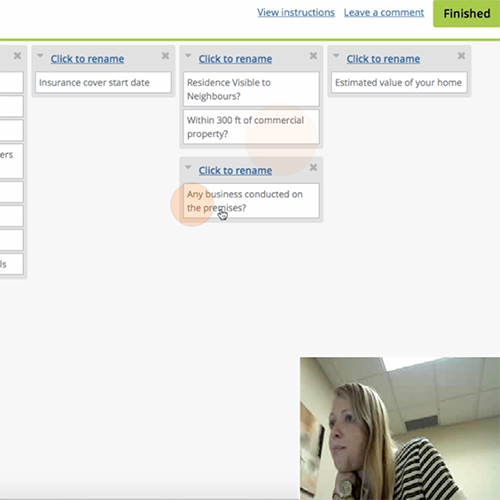SaaS Research - Experience Design
Software Product House
Background
This company develops enterprise insurance software, and had an existing suite of highly successful on-premise hosted admin and web applications, both internal and consumer-facing. With this project, this company wanted to develop a next-generation SaaS product aimed at providing cutting-edge digital experiences, enabling new capabilities for insurers and new possibilities for the consumer. I was the design lead for the first journeys to be built - quote-and-buy, account management and claims. Though this section is purely about the research and testing efforts for this project, I also worked on the Service Design, planning and front-end design.
What I Did
In parallel with efforts on project strategy, I facilitated a user research session at the beginning of a development project for the planned quote-and-buy user journey. Following research-planning and sourcing activities, the first session was run with five users.
There were two goals for this session. The first was to conduct generative research (i.e. ideation), done through de-contextualised interviews to ask questions about the group's experiences and gain insight into potential new approaches to problems. The second goal was to conduct evaluative research, done by running usability benchmarking tests against an existing app as well as running a card-sort. Here a "think out loud" technique was used to create cognitive empathy with the users. The sessions were conducted live in a lab in New York, recorded and subsequently analysed.
Informed by user research findings and desk-research, I began to create personas to guide subsequent development. The personas aggregated various aspects of a real end user's interaction with our apps, conveying their motivations, expectations and pain-points. Once I completed the full set of customer personas they were discussed with Product Management and the dev team to promote understanding. The personas were used to guide discussions around features.
At the same time, work began on clickable prototypes. Once first features and flows had been mocked-in (again, informed by initial interview/card-sort feedback), iterative testing was carried out with remote users fom the group. Outputs from every recorded session wer used as inputs to the next round of design/prototyping.
What Were The Outcomes?
Apart from the obvious outcome - a feedback loop from real end users being incorporated into design - the other main outcome was the establishment of a pretty solid set of research/testing/analysis/reporting methods. Through this however, the need for a more standardised, sharable approach to research and testing was identified. This gave rise to proof of concept work for testing platforms - specifically UserZoom.
Client
Software Product House
Techniques
Interviewing, Observation, Usability, Card Sorting, Analysis, Persona Creation
Technologies
Recording software, OptimalSort, UserZoom, Adobe Illustrator



